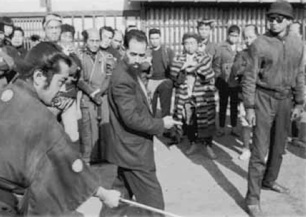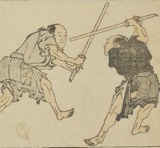Tenshin Shoden Katori Shintô Ryu Budô Kyôhan
by Yoshio Sugino & Kikue Ito
Tenshin Shôden Katori Shintô-ryu is often regarded as the oldest historically traceable sword tradition of Japan. But it may also be the most accessible school for non-Japanese practitioners. This fact is partly due to the energetic efforts of the late Yoshio Sugino; when only foreigners who resided in Japan were allowed to train in the Narita dojo of Ôtake Risuke, Sugino opened his Kawasaki dojo to all who were interested and he travelled to Europe to bring kobudo to his students.

Nearly seventy years after its first appearance in Japan, Tenshin Shôden Katori Shintô Ryu Budo Kyôhan is now published in a western language. Translated into German by Izumi Mikami-Rott and Ulf Rott, a new generation of budoka can get acquainted with the work of Sugino Yoshio. The book looks good. Although the cover design somewhat resembles a New Age publication, the many photographs have been reproduced without further loss of quality. There is a preface by the current sôke and an additional supplement of thirty pages with, among other things, a historical overview of Sugino’s Yuishinkan dojo and a glossary with explanations about things like techniques, religious matters, measurements et cetera. The Japanese text of Budo Kyôhan is well translated; difficult concepts are explained in brackets and specific words and concepts are maintained in Japanese next to the German translation.
Looking at the contents, a comparison with Katori Shintô-ryû, Warrior Tradition (based on the Deity and the Sword series) by Ôtake Risuke becomes obvious. Both writers approach their subject from different angles however. Where the book of Ôtake for a large part consists of series of photographs of the curriculum without any further explanation, Sugino focusses on describing the contents of the kata in an extensive text. In his book he treats omote sword, bô, naginata, together with iai-jutsu and he reserves much space for detailed explanations on kamae, ma-ai, execution of techniques and other basics. In some cases this leads to interesting discrepancies with Ôtake’s text. In the discussion of the iai kata kusanagi no ken for example, the position tate-ichimonji is described as a transitional moment between yoko ichimonji (or torii no kamae) and jôdan no kamae, while according to Ôtake this movement must be seen as an atemi strike with the tsuka.
Another clear difference between both books is the treatment of religious backgrounds. Ôtake describes extensively (mikkyô-)buddhist, taoist and confucianist elements of which the connection with Katori Shintô-ryu is sometimes clear (for example in the case of the use of the taoist gogyô system in the context of chikujôhô, the development of fortifications), but in other cases might not be more than general religious concepts. In Budô Kyôhan Sugino limits himself to the treatment of the shintoist roots of Katori Shintô-ryu. His ideas about nihon damashii are discussed in a militant tone and include an interesting elaboration on the usefulness of the Japanese sword in modern combat. His book paints a clear picture of the militaristic rhetoric of pre-war Japan and the part budo played in this.
Present-day practitioners of Katori Shintô-ryu are faced with two currents within the ryu that have grown apart in the way the kata are executed and sometimes discussions can be heard about what KSR must have looked like before this division had taken effect. In this respect Budô Kyôhan was written in a very interesting period in the history of the ryu, when the responsibility for the continuation of it was shared by a group of shihan, who must all have left their personal mark on the way they instructed their students. If we are to believe some sources, the Ôtake line is the only true line of Katori Shintô-ryu in existence today and there are even those who claim that the practitioners of other organizations are no more than frauds. The fact that in his preface to Budô Kyôhan Sugino Yoshio thanks Iizasa sôke and six shihan, among whom the teacher of Ôtake Risuke, Hayashi Yazaemon sensei, for their support in the realization of this book, leads one to believe that sixty years ago the ryu was less polarized.

Publisher: Books on Demand GmbH
Language: German
ISBN: 978-3-8423-0682-0
English edition
Published by Ulf Rott, 2016
ISBN: 978-1-326-77050-1
